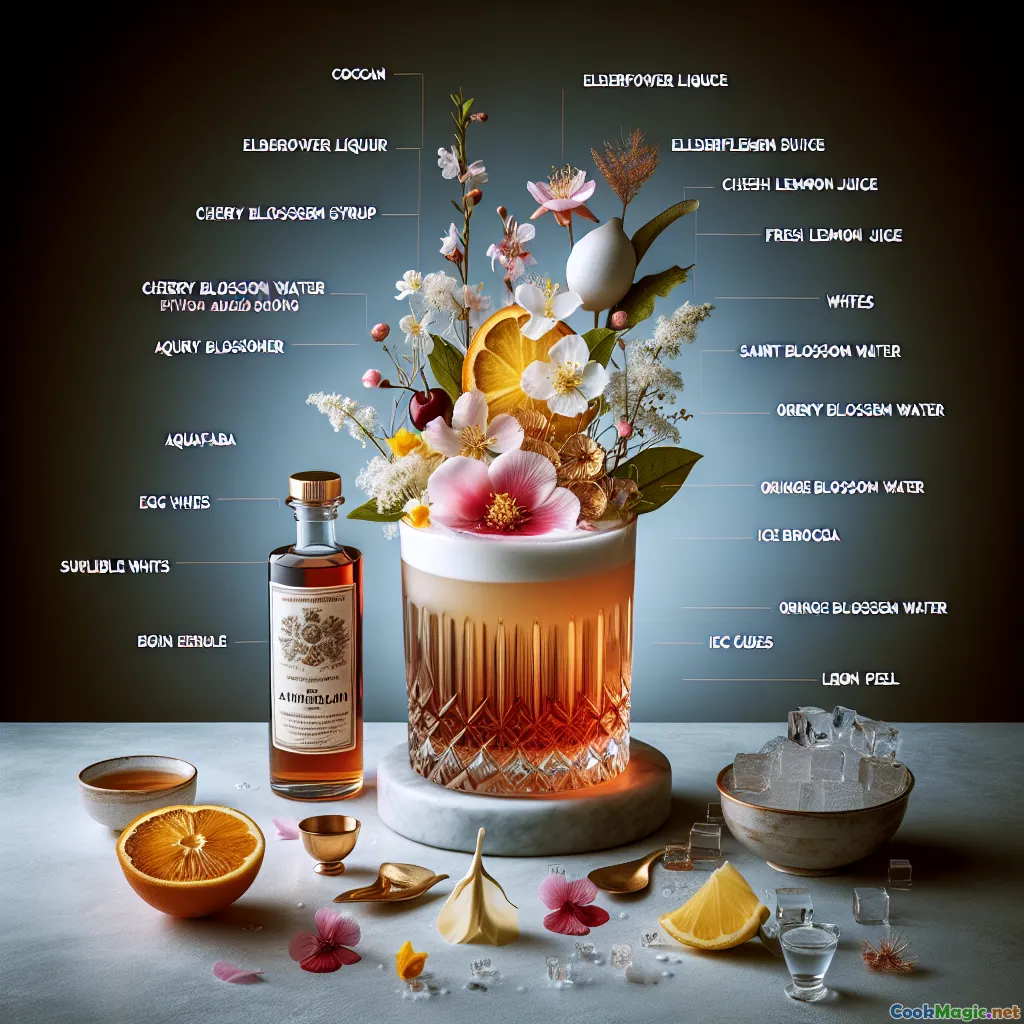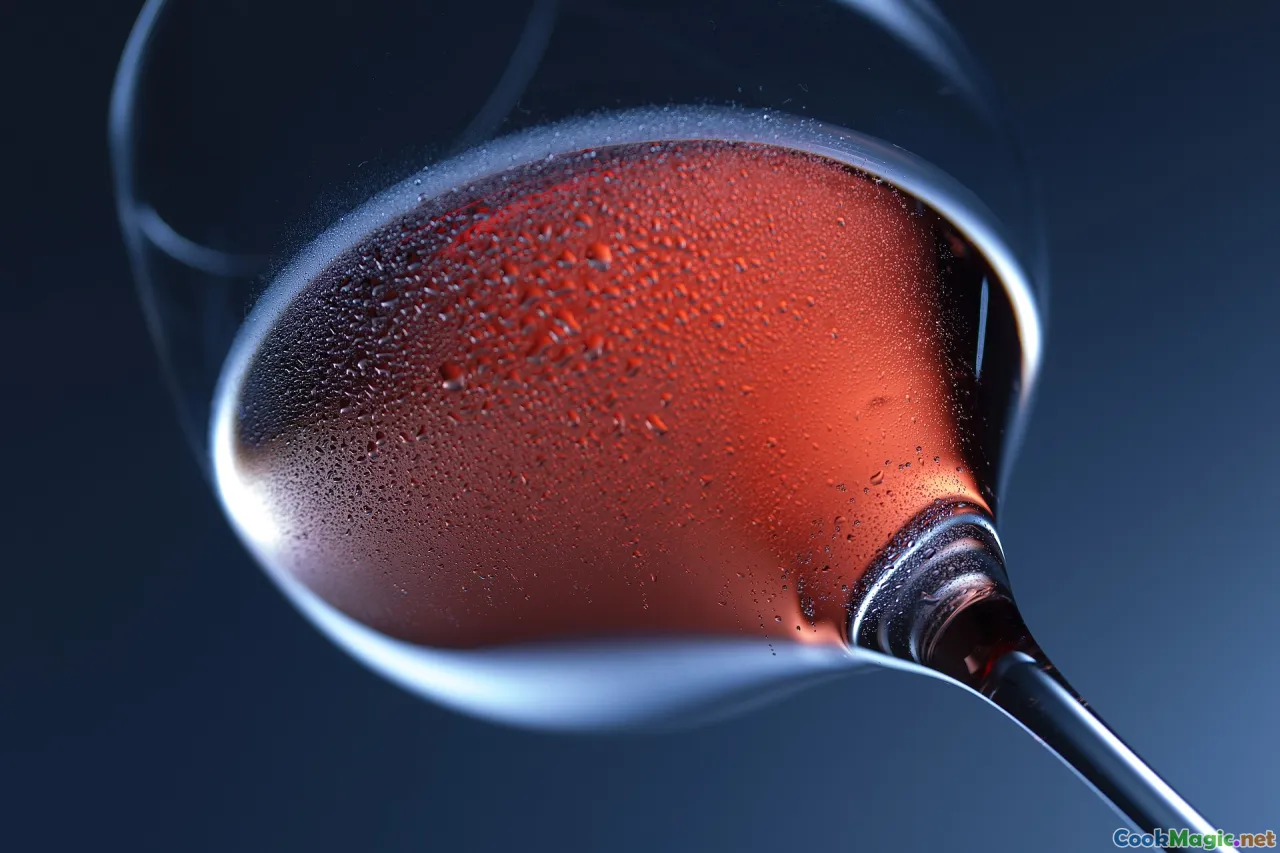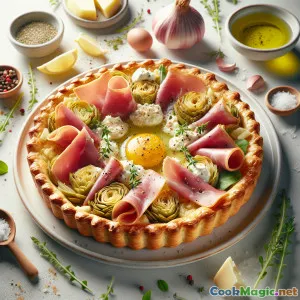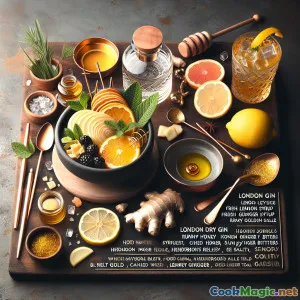
Vinho azedo com aroma de flores de Saint-Émilion
(Saint Émilion Blossom Wine Sour)
(0 Avaliações)0
133
outubro 26, 2025
Reportar um problema
Ingredientes
-
90 ml Cognac
(Use VS or VSOP; fruit-forward styles work best.)
-
40 ml Licor de Flor de Sabugueiro
(Adds floral sweetness; adjust to taste.)
-
50 ml Suco de Limão Fresco
(Espremido na hora para brilhar.)
-
20 ml xarope de flor de cerejeira (sakura)
(Sub with rose syrup if sakura is unavailable.)
-
2 Claras de ovo Claras de ovo
(Pasteurized; for a silkier foam.)
-
60 ml aquafaba
(Vegan alternative to egg white; use instead of eggs.)
-
40 ml Vinho tinto Saint-Émilion
(Float; medium-bodied Merlot-dominant works best.)
-
4 drops água de flor de laranjeira
(Amplifies floral notes; use sparingly.)
-
4 drops Solução salina a 10%
(Enhances flavor integration; optional but effective.)
-
16 pieces Cubos de Gelo
(Fresh, hard cubes for better aeration and chill.)
-
2 pieces Flores comestíveis
(Sakura, viola, or micro-flowers for garnish.)
-
2 strips Casca de limão
(Expressed oils over the surface; optional accent.)
(Use VS or VSOP; fruit-forward styles work best.)
(Adds floral sweetness; adjust to taste.)
(Espremido na hora para brilhar.)
(Sub with rose syrup if sakura is unavailable.)
(Pasteurized; for a silkier foam.)
(Vegan alternative to egg white; use instead of eggs.)
(Float; medium-bodied Merlot-dominant works best.)
(Amplifies floral notes; use sparingly.)
(Enhances flavor integration; optional but effective.)
(Fresh, hard cubes for better aeration and chill.)
(Sakura, viola, or micro-flowers for garnish.)
(Expressed oils over the surface; optional accent.)
Nutrição
- Porções: 2
- Tamanho da Porção: 1 coupe (150 ml)
- Calories: 190 kcal
- Carbohydrates: 12 g
- Protein: 2 g
- Fat: 0 g
- Fiber: 0 g
- Sugar: 10 g
- Sodium: 35 mg
- Cholesterol: 0 mg
- Calcium: 15 mg
- Iron: 0.3 mg
Instruções
-
1 - Chill and Prepare:
Chill two coupe glasses with ice or in the freezer. Set out all ingredients, a shaker, a fine strainer, and a barspoon.
-
2 - Build the sour:
In a shaker, add cognac, elderflower liqueur, lemon juice, cherry blossom syrup, saline (if using), and orange blossom water. Add egg whites or aquafaba (not both).
-
3 - Dry Shake for Foam:
Seal the shaker without ice and shake vigorously for 15–20 seconds to emulsify and create a stable, silky foam.
-
4 - Shake with Ice:
Open the shaker, add ice cubes, and shake hard for 15–20 seconds until the tin is frosty and the mixture is well aerated.
-
5 - Strain and float the wine:
Dump ice from the coupes. Double-strain the cocktail into the glasses. Slowly pour Saint-Émilion red wine over the back of a barspoon near the surface to create a floating layer.
-
6 - Garnish and Serve:
Express lemon peel over each drink and discard or rim the glass. Garnish with an edible blossom. Serve immediately with the distinct red float intact.
Chill two coupe glasses with ice or in the freezer. Set out all ingredients, a shaker, a fine strainer, and a barspoon.
In a shaker, add cognac, elderflower liqueur, lemon juice, cherry blossom syrup, saline (if using), and orange blossom water. Add egg whites or aquafaba (not both).
Seal the shaker without ice and shake vigorously for 15–20 seconds to emulsify and create a stable, silky foam.
Open the shaker, add ice cubes, and shake hard for 15–20 seconds until the tin is frosty and the mixture is well aerated.
Dump ice from the coupes. Double-strain the cocktail into the glasses. Slowly pour Saint-Émilion red wine over the back of a barspoon near the surface to create a floating layer.
Express lemon peel over each drink and discard or rim the glass. Garnish with an edible blossom. Serve immediately with the distinct red float intact.
Mais sobre: Vinho azedo com aroma de flores de Saint-Émilion
Saint Émilion Blossom — Story, Technique, and Tips
The Saint Émilion Blossom is a refined French-inspired wine sour that fuses the elegance of Bordeaux with the perfume of spring blossoms. Imagine the structure of a New York Sour, but reimagined through a floral lens: a cognac-and-elderflower base, brightened by lemon and sakura syrup, topped with a crimson float of Saint-Émilion red wine. The look is dramatic—cream-white foam beneath a translucent ruby cap—while the flavor arcs from citrus and flowers to supple red fruit and soft tannin.
Why Saint-Émilion? This right-bank Bordeaux appellation is celebrated for Merlot-driven blends that showcase plush plum, red cherry, and refined tannins. Those fruit notes play beautifully with elderflower’s pear-and-lychee lift, and lemon’s acidity knits the elements together. Instead of burying the wine in the shaker, we float it atop the drink. This preserves its aromatic signature and creates a layered sip: first your nose meets Bordeaux, then your palate finds blossoms and citrus, and finally a gentle echo of oak and spice from the cognac.
The technique follows classic sour construction with a modern twist. The dry shake is essential if you want that luscious, meringue-like foam. It emulsifies the proteins in egg white (or aquafaba), trapping tiny bubbles that create a silky texture and a pillowy cap to support the wine float. A second shake with ice chills, dilutes, and aerates—dilution matters in this cocktail because it tames sweetness and allows floral notes to bloom without stickiness.
When choosing the wine, reach for a medium-bodied Saint-Émilion that’s not overly oaky or heavily extracted. You’ll want moderate tannin and bright red fruit; a younger bottle works well. A Merlot-dominant blend at 13–14% ABV typically offers enough intensity to sit aromatically on the foam without overpowering the drink. Pour the float gently over the back of a barspoon just above the surface; the lower-density cocktail base helps the wine rest as a thin layer, creating that signature two-tone presentation.
Flavor-wise, the drink opens with a kiss of red cherry and plum, then glides into a citrusy, floral heart, finishing dry and clean. Elderflower liqueur sweetens, but lemon and the tannic nudge of Bordeaux restore balance. Cherry blossom syrup (or rose syrup in a pinch) deepens the floral impression without leaning into perfumey excess—keep it measured. A couple of drops of orange blossom water can be lovely, but treat it like cologne: you should sense it, not taste it.
Tips and notes:
- Egg white vs. aquafaba: Aquafaba (chickpea brine) is a terrific vegan alternative and produces a stable foam. Use 25–30 ml per drink. If using egg whites, pasteurized eggs are recommended for safety.
- Saline solution: A 10% saline (10 g salt in 100 ml water) used in drops integrates flavors and nudges fruit and floral tones forward without tasting salty. If you don’t keep saline, a very tiny pinch of fine sea salt in the shaker works too.
- Sweetness balance: If your elderflower liqueur is particularly sweet, reduce the sakura syrup by 5 ml or add 5 ml more lemon to maintain a crisp finish.
- Temperature and dilution: Hard, fresh ice gives consistent aeration and controls dilution. Shake until the tin frosts; an under-chilled sour can taste cloying and blunt the floral high notes.
- Garnish thoughtfully: Edible blossoms (sakura, viola, borage) add visual poetry. Express a lemon peel over the top to bridge citrus oils with the wine’s aromatic lift, then discard or use as a rim rub so it doesn’t dominate the bouquet.
Cultural context and inspiration: Saint-Émilion itself is a UNESCO-listed medieval village, synonymous with hospitality and storied châteaux. This cocktail nods to its heritage by letting the wine remain recognizable, not just an anonymous component. The “Blossom” moniker evokes hanami traditions and spring revelry, tying together French terroir and a broader global appreciation for floral flavor. It’s a drink for transitional seasons—when winter’s edges soften and fresh herbs, flowers, and longer evenings invite aperitif culture back to the patio.
Service suggestions:
- Aperitif pairing: Serve with salted Marcona almonds, goat cheese crostini, or a strawberry-and-fennel salad. The drink’s acidity and floral tones flatter fresh dairy and spring produce.
- Glassware: A chilled coupe or Nick & Nora concentrates aroma and showcases the layered look. If you prefer a longer, spritzier style, strain over a large cube in a rocks glass and add a restrained 30–45 ml splash of chilled soda; skip the wine float or keep it minimal.
In essence, the Saint Émilion Blossom marries classic technique with terroir-respectful flair. It’s equal parts theater and taste—a poised, modern French cocktail that blooms from the first glance to the last sip.



















